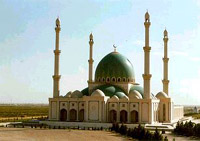Turkmenbashi: Death of Soviet holdover and vacuum of future
Many people inside and outside Turkmenistan were taken aback by the death of the country’s longtime totalitarian leader Saparmurat Niyazov announced on Thursday. On the other hand, the passing of Niyazov was an event waiting to happen for several years. It effortlessly proves a rather hackneyed historic truth: even the most crooked despot will be powerless when it is curtains.

Niyzov’s unlimited powers enabled him to do to his country whatever he wanted to for two decades. He did not leave any alternative to his countrymen, nay, a hint of alternative is out of the question for those who were kept as hostages to Niyazov’s cult of personality and madcap schemes capable of reducing to sawdust his most loyal henchmen once they fell out of favor. What happens next?
Who can answer the question: What is in store for Turkmenistan? Will the regime built by Niyazov be kept intact by some Turkmenbashi II taking advantage of his predecessor’s experience? Will the desacralization of Niyazov get started and how will it look like? There are several scenarios of Turkmen destalinization: Turkmenbashi’s personality cult may be exposed by making public numerous cases of abuse of power committed by the author of Ruhnama, an official bible allegedly penned by Niyazov. Alternatively, some unscrupulous comrades of arms of the “great leader” (those who lost a power-jockeying) may be handpicked for the role of scapegoats to take the blame for all the sins of the dictatorship. Will the stability of Turkmenistan be preserved should this kind of destalinization go under way? Will the country be able to resist foreign influence? And what nation or a group of nations is going to get the upper hand in a contest for Turkmenistan? Will it be Russia, the West or Iran?
Today’s Turkmenistan is like a ship without a steering gear and without sails, a totally disoriented nation whose future looks quite obscure. More importantly, its past is obscure too because nobody knows how it is going to be interpreted by those who will come to power.
Some 15 years ago nobody expected that the Communist Party boss of Turkmenia would go at full tilt and create an absolute dictatorship in the desert nation rich in natural resources. Compared with the caliber of Nursultan Nazarbayev’s personality and analytical capacity of Islam Karimov, Niyazov looked like an underdog. Unlike Nazarbayev and Karimov, he could not charm people in a conversation nor could he impress them with unexpected revelations and pinpoint assessments. However, he did have plenty of push and an immense lust for power; he was ready to go to the very end without looking back or noticing anybody.
Niyazov’s confidence in his mission, in his role may have puzzled commentators andanalysts at the beginning. On the face of it, such a man was not supposed to cut a bigger-than-life figure in terms of absolute power and an all-encompassing personality cult. But all the doubts faded to black once it became clear that his mission had nothing to do with Turkmenia, his mission was Niyazov himself.
This amazing person had been building a monument to himself thought his life. He used a Soviet republic that later became an independent state as a foundation for erecting his gilded statue. Unlike many other nations of the world, Turkmenistan provided vast opportunities for carrying out such a construction project. Niyazov did not seem to know exactly whom he wanted to imitate in self-adulation, and therefore he tended to fidget, borrowing heavily from a few well-known examples. Did he want to be another Brezhnev? Stalin? Ataturk? The builder of a modern state at the East? A general secretary? The father of the nation? The cult of personality built by Niyazov was a motley construction; Niyazov used all his ideas plus advice courtesy of his aids. As a result, the cult looked like the most eclectic and weirdest one of all in terms of the former Soviet Union and the rest of the modern world. The cult resembled assorted methods of worshipping presidents in a number of new African states.
But any eclectic technique of a kind proves to be secondary once we look back and recall the coronation of Jean-Bedel Bocassa of the Central African Republic – the president who wanted to become an emperor and fashioned himself after his hero, Napoleon I of France. We may as well recall homage paid to Idi Amin in Uganda and to Mobuto Sese Seko in Zair in their time. However, we can estimate the true value of a cult only after the demise of the “father of the nation.”
Is Turkmenistan a museum named after Niyazov featuring his freshly airbrushed portraits and monuments or a state that is obsolete yet capable of running after its leader’s death? It is highly unlikely that we will get an answer to this question in the next several weeks or even months. It is important to know the answer since Turkmenistan with its vast reserves of natural gas was an important part of the entire system of international relations of the post-Soviet era, all those corporate dealings and maneuvers by Moscow, Kiev, Tashkent, and Astana…The point is that the maneuvers were actually based on personal arrangements with one person, not with the government. The circumstance is a sign of weakness of the system. In fact, the person in question made a lot of effort trying to project his immortality, which was a myth.
Source: Politkom.ru
Translated by Guerman Grachev
Pravda.ru
Subscribe to Pravda.Ru Telegram channel, Facebook, RSS!


